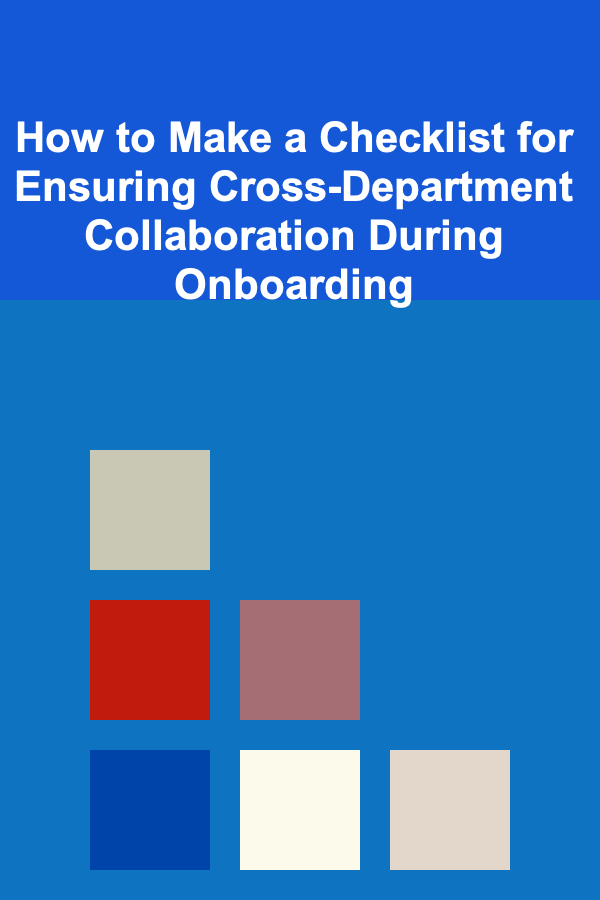
How to Make a Checklist for Ensuring Cross-Department Collaboration During Onboarding
ebook include PDF & Audio bundle (Micro Guide)
$12.99$11.99
Limited Time Offer! Order within the next:

Onboarding is a critical process that sets the foundation for new employees to succeed in their roles and integrate into a company's culture. However, an often-overlooked aspect of onboarding is cross-department collaboration. When departments collaborate effectively during onboarding, new hires gain a comprehensive understanding of the company's structure, operations, and culture, which enables them to perform at a higher level.
Creating a checklist for ensuring cross-department collaboration during onboarding helps streamline the process, ensuring that all relevant teams are involved and the new employee receives a holistic introduction to the organization. In this guide, we'll discuss how to develop a robust checklist to ensure smooth interdepartmental coordination during onboarding.
Step 1: Define the Purpose and Objectives of Cross-Department Collaboration
Before diving into the logistics of creating a checklist, it's important to define why cross-department collaboration matters during onboarding. Understanding the purpose will help you design the checklist in a way that aligns with organizational goals and the new hire's success.
1.1 Clarifying the Onboarding Goals
The primary objective of cross-department collaboration is to introduce the new employee to various departments, creating a sense of interconnectedness and fostering a deeper understanding of how their role impacts the broader organization.
The goals of involving multiple departments during onboarding might include:
- Building interdepartmental relationships: New hires should understand how their department works with other teams and the value of cross-functional communication.
- Providing holistic job training: The new hire should not just understand the technical aspects of their job but also how their team fits into the overall organizational workflow.
- Cultivating a sense of company culture: Understanding the values, practices, and mission of other departments creates a more unified workplace culture.
- Encouraging collaborative problem-solving: By interacting with different teams, employees can better understand how to solve challenges through collaboration.
1.2 Setting Expectations for Collaboration
Clearly set expectations for all departments involved. What role should each department play? How can they support the onboarding experience? When everyone understands their role, collaboration becomes more effective.
Step 2: Identify Key Departments and Stakeholders
The next step in creating a checklist is to identify which departments will play an active role in the onboarding process. Depending on the size and complexity of the organization, multiple teams may be involved. These departments should be aligned with the goals outlined in Step 1.
2.1 Key Departments to Include in the Onboarding Process
- Human Resources (HR): HR usually oversees the onboarding process, ensuring that new hires have all the necessary paperwork, benefits information, and company policies. They should collaborate with other departments to personalize the experience.
- IT Department: The IT department is essential for setting up necessary equipment, software, and access to company systems. They must ensure that new hires have the tools needed to collaborate effectively with other teams from day one.
- Direct Department (New Hire's Team): The new hire's immediate team will be the primary group the employee works with. Managers and team members should ensure the new hire understands their department's specific goals, projects, and workflows. Cross-departmental introductions can happen at this level.
- Marketing and Communications: Marketing can be involved in helping new hires understand the company's branding, messaging, and external communications strategy. This is especially important for customer-facing roles.
- Sales Team: For employees who work closely with clients or customers, the sales team is important to help the new hire understand customer needs, pain points, and how to build strong relationships.
- Finance Department: Ensuring that new hires understand the financial structure, budgets, and financial policies can be crucial for employees who will handle resources or make financial decisions.
2.2 Key Stakeholders
Apart from department representatives, there are other key stakeholders, such as mentors, direct managers, or even senior leadership. These individuals should be included in the checklist as they play an integral role in guiding the new hire.
- Mentors: Mentors from various departments can be pivotal in helping the new hire navigate cross-departmental relationships and better understand how different teams contribute to the company's goals.
- Direct Manager: The new hire's direct manager should oversee the entire onboarding process, ensuring coordination between departments and facilitating introductions.
Step 3: Design a Cross-Departmental Onboarding Schedule
An effective checklist should include a clear schedule that outlines when each department's involvement is necessary. A cross-departmental onboarding schedule allows each department to contribute at the right time, ensuring smooth coordination.
3.1 Create a Timeline for Key Onboarding Events
Here's an example of how you might structure a cross-departmental onboarding timeline:
-
Day 1: Welcome and Introduction
- HR: Welcome session, office tour, introduction to company culture, benefits information.
- IT: Set up new hire's workstations, provide access to email, and company systems.
- Direct Team: Introductions to team members, overview of team goals and projects.
-
Day 2: Department-Specific Training
- IT: Introduction to tools, software, and systems the employee will use.
- Direct Team: Provide role-specific training, project overview, and expectations.
-
Day 3-4: Cross-Department Introduction
- Marketing: Provide an overview of brand messaging, external communications, and the customer journey.
- Sales: Introduce customer profiles, sales processes, and sales goals.
- Finance: Brief overview of budget management, financial reporting, and key financial systems.
-
Week 2: Deep Dive into Collaborative Processes
- Direct Team: Share current projects and processes that require cross-departmental collaboration.
- HR/IT/Marketing/Sales: Hold a Q&A session for the new hire to ask questions about different departments' workflows and responsibilities.
3.2 Assign Department-Specific Tasks and Responsibilities
Ensure that each department is given specific tasks during onboarding, such as:
- HR: Reviewing and explaining company policies, handling paperwork, conducting culture training.
- IT: Ensuring technical setup and resolving any system access issues.
- Direct Team: Introductions to team roles, expectations for collaboration, and workflows.
- Other Departments: Provide detailed training in their respective functions, emphasizing how the new hire will interact with their departments.
Step 4: Facilitate Communication and Collaboration Between Departments
Cross-department collaboration during onboarding requires open channels of communication. A checklist should include strategies for ensuring smooth interaction between departments.
4.1 Create an Onboarding Hub
An online hub where all relevant information and resources are shared can improve communication and streamline onboarding. It can serve as a centralized location where new hires can access:
- Company-wide documents and policies.
- Departmental training materials.
- Cross-departmental collaboration tools and guides.
4.2 Use Collaborative Tools
Utilize collaboration tools such as Slack, Microsoft Teams, or Asana to create channels or project boards specifically for onboarding tasks. These tools should be used to:
- Facilitate real-time communication between departments.
- Ensure tasks are tracked and completed on time.
- Allow new hires to ask questions or seek clarifications from different teams.
4.3 Facilitate Regular Check-Ins
Hold regular check-in meetings with key stakeholders from each department to assess the onboarding process's effectiveness. This ensures that no department is left out and that the process remains aligned with the company's overall objectives.
Step 5: Evaluate and Adjust the Cross-Departmental Onboarding Process
The final step in creating an effective cross-departmental checklist is evaluating and adjusting the onboarding process. After the new hire completes the onboarding process, gather feedback from both the new hire and the departments involved.
5.1 Solicit Feedback from the New Hire
Ask the new employee for their perspective on the cross-departmental onboarding experience. Were they able to connect with each department effectively? Did they feel supported in understanding their role within the broader organization?
5.2 Gather Feedback from Stakeholders
Request feedback from all departments involved in the onboarding process. Were there any challenges in collaborating with other departments? Were there gaps in communication that could be improved?
5.3 Analyze and Adjust
Based on feedback, make adjustments to the checklist and onboarding process. Address any issues that arose during the collaboration process and refine the scheduling, communication methods, and department responsibilities accordingly.
Conclusion
Ensuring cross-department collaboration during onboarding is essential for providing new hires with a well-rounded understanding of their role within the company. By designing a detailed checklist that includes key departments, timelines, roles, and communication strategies, you can streamline the process and create a seamless experience for the new hire. This not only helps the new employee integrate quickly but also fosters stronger relationships and collaboration between teams across the organization. Regular evaluation and refinement will further enhance the effectiveness of the onboarding process, leading to long-term success for both new hires and the company as a whole.

The Marketing Manager's Guide: Strategies for Driving Brand Success
Read More
How To Find TV Shows That Feature Magical Realism
Read More
How To Create a Healthy Work-Life Balance Remotely
Read More
How to Apply Stoic Wisdom to Modern Life Challenges
Read More
Finding Books That Play with Narrative Structure
Read More
10 Tips for Optimizing Natural Light in Your Home
Read MoreOther Products

The Marketing Manager's Guide: Strategies for Driving Brand Success
Read More
How To Find TV Shows That Feature Magical Realism
Read More
How To Create a Healthy Work-Life Balance Remotely
Read More
How to Apply Stoic Wisdom to Modern Life Challenges
Read More
Finding Books That Play with Narrative Structure
Read More